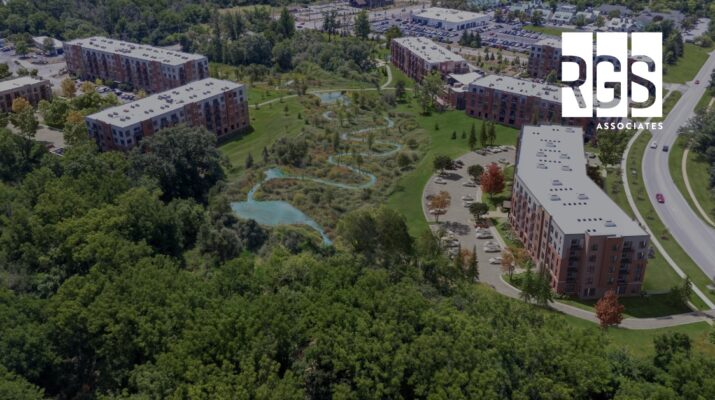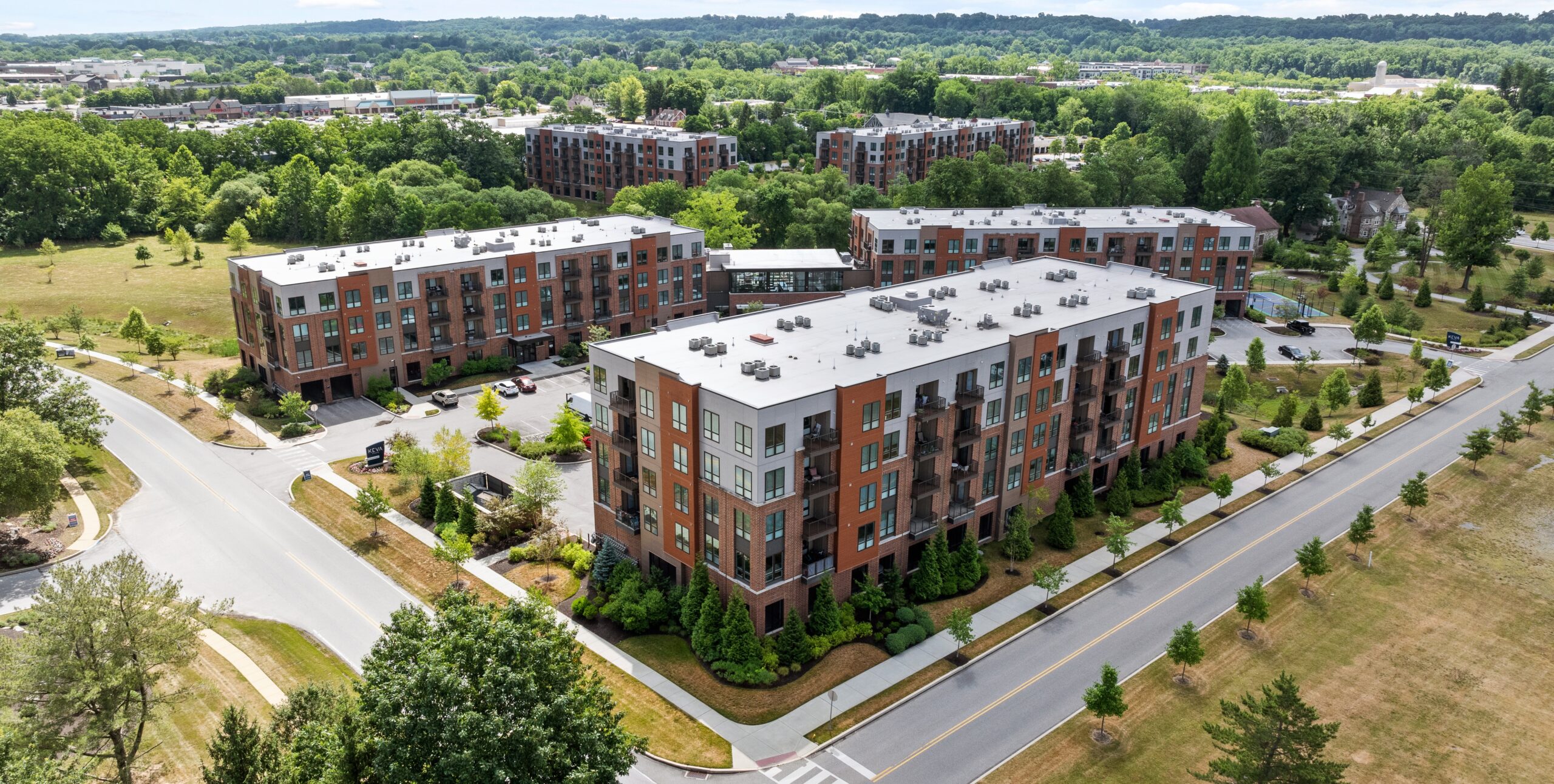RGS and The Hankin Group: Engineering Success at Keva Flats

The story of RGS Associates’ involvement with Keva Flats, a luxury apartment community in Exton, PA, began with a presentation about stream restoration at Penn State University.
According to The Hankin Group’s Vice President of Development, Neal Fisher, the Pennsylvania Housing and Research Center (PHRC) hosted the presentation in 2017. The Hankin Group developed Keva Flats.

“RGS and Land Studies had figured out how to implement and use floodplain management systems for stormwater management,” Neal said. “It piqued my interest, because we were just finishing up the initial phase of Keva Flats, and we wanted to see if we could integrate this type of stormwater management into our project.”
The first phase of the project—the phase that was finishing up at the time—included the construction of 242 units, a 10,000-square-foot community building, a swimming pool, walking trails, and public highway improvements. Phase II, which is scheduled for completion in 2026, will add 96 units to the project.
Neal wasn’t at the presentation by accident. The Hankin Group has been integral in the creation of the Pennsylvania Housing Research Center (PHRC). The company’s founder, Bernie Hankin started the PHRC with an endowment in 1979. The goal of the center is to further engineering excellence in the home building industry through teaching, research, technology transfer, and public service.
The timing couldn’t have been better for Keva Flats, Neal said.
“I already knew we had a pretty large basin that was taking up a lot of space on the property,” he said. “After the presentation, I asked RGS if they’d be willing to take a look at the project, and they did. They came out and did an evaluation.”
A Perfect Site for Environmental Innovation

“This was the ideal site to do one of these floodplain restorations,” said Bill Fredericks, Principal at RGS Associates.
“You’ve got an older straight stream from a farm. You take the floodplain, you restore it back to more original conditions, but with a design intent. You slow it down, and you get water quality benefits for the developer, but also better stormwater management practices from the standpoint of the township and DEP [the PA Department of Environmental Protection].”
The restoration project was not without its challenges, however. Close coordination was necessary between RGS and LandStudies throughout the design process, along with multiple stakeholders, which included the developer, the municipality of West Whiteland Township, DEP, and even the US Environmental Protection Agency (EPA).
RGS Associates helped navigate the conditional use process and secure necessary approvals for work within this environmentally sensitive area.
Township Support and Environmental Benefits

West Whiteland Township quickly recognized the project’s potential benefits for the community. The restoration project removes approximately 50,000 pounds of sediment annually from the watershed.
Rather than requiring The Hankin Group to pay standard impact fees for open space, recreation, and traffic, the township allowed those funds—approximately half a million dollars—to be invested directly into the floodplain restoration.
“This is one of those projects that was really a win-win situation,” Neal said. “It’s a win from an environmental perspective, it’s a win from a township perspective, and it’s a win from the perspective of the MS4 program.”
The DEP administers the federal Clean Water Act requirements through its Municipal Separate Storm Sewer program (a.k.a. MS4). One of the key components of this program is the implementation of a stormwater management program for minimizing the impacts of stormwater and snow melt runoff within urbanized areas.
Navigating Complex Permitting Requirements
One of RGS Associates’ key contributions was helping The Hankin Group secure an NPDES permit to implement the restoration project.
The NPDES (which stands for National Pollutant Discharge Elimination System) is an EPA program that governs runoff that doesn’t soak into the ground and picks up pollutants such as chemicals, trash, oils, and other dirt and sediment as it is discharged. The NPDES regulates this overflow by requiring a permit for new construction projects that might create this kind of runoff.
In Pennsylvania, PA DEP handles NPDES permitting, and the process can be time-consuming, Neal said.
“Because of how far along we were and because of the work that was going to be done within the stream bed, I was nervous about the timing,” he said. “It actually went much quicker than I thought.”
While strong community support helped move the project forward, Fisher emphasized that success ultimately came down to having well-prepared plans.
“At the end of the day, you need to have good plans,” Neal said. “And I have to give Bill a lot of credit—he provided us with quality plans and engineering services.”
The entire approval process, from conditional use submission to NPDES approval, took approximately 18 months—remarkably efficient for a project of this size and scope.
Enhancing Natural Beauty

The restoration involved thoughtful consideration of both function and aesthetics. Rather than using traditional dead tree snags to slow water velocity, the team opted to incorporate live trees.
“We purchased six-to-eight-inch diameter live trees to incorporate into the project,” Neal said. “We still utilized some dead trees for functional purposes, but replaced many snags with live trees, and it really adds a lot—not only to the floodplain restoration, but also to the site’s aesthetics.”
Strategic Location and Development
Besides meeting the stormwater management requirements, the floodplain restoration project also aligns perfectly with West Whiteland Township’s development goals.
“We are in the town center zoning, which is where the township wants to have its greatest density,” Neal said. “It’s where they want to have their greatest number of commercial areas for retail, but it’s also where they want to have their greatest number of homes. This project is putting those homes exactly where they’re intended to be.”
A Foundation for Future Collaboration

The successful partnership between RGS Associates and The Hankin Group on the Keva Flats was the first of several projects upon which the two firms have since collaborated.
“If I didn’t think that Bill and the team over there at RGS was doing a good job, we wouldn’t have sent them more work,” Neal said. He added that RGS’ innovative floodplain restoration plan and accompanying permitting follow-through impressed everyone.
Neal emphasized that projects like this aren’t easy to put to bed for several reasons. First, the permitting requirements can be onerous and require a tremendous amount of time and attention to detail. Additionally, getting the developer, the township, other engineering teams, and state and federal environmental agencies all in alignment can be extremely difficult.
“There are a lot of players,” Bill said. “When you get into this type of design, it’s not as straightforward as your typical stormwater management plan has been for the past 50 years.”
The Keva Flats floodplain restoration project shows how thoughtful engineering, careful planning, and innovative design can help both environmental sustainability and community development. The project not only achieved its environmental goals but also helped establish Keva Flats as one of the region’s premier apartment communities.
And it didn’t hurt that Neal has an engineering background, Bill said.
“That can make it so much easier,” he said with a laugh. “You can speak in that engineer lingo and he knows exactly what you’re talking about.”
Today, as residents walk their dogs along the restored stream corridor, they might not realize the complex engineering and careful planning that went into creating this natural-looking landscape. But for the teams at RGS Associates and The Hankin Group, it represents what’s possible when development and environmental stewardship work in harmony.
“RGS as a whole is a great organization,” Neal said. “They are great to work with. And Bill? Bill is great. He helped make Keva Flats a really nice success story.”




